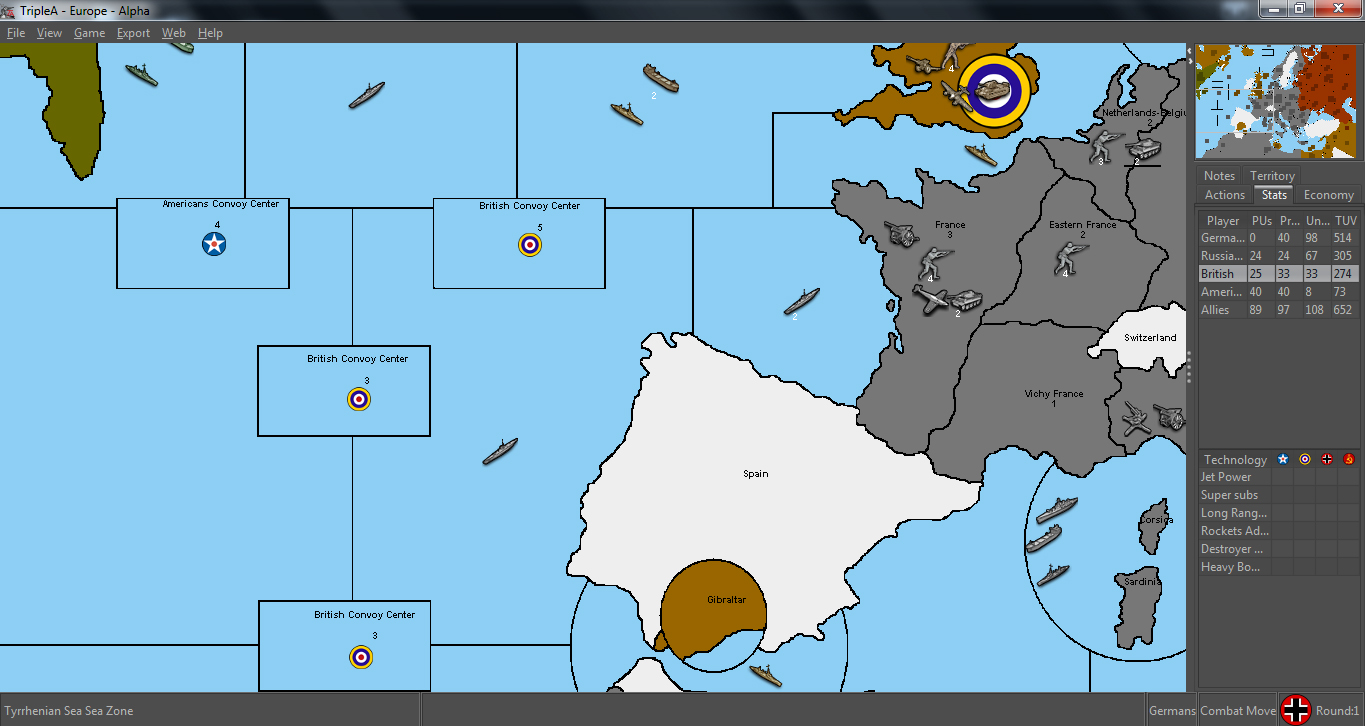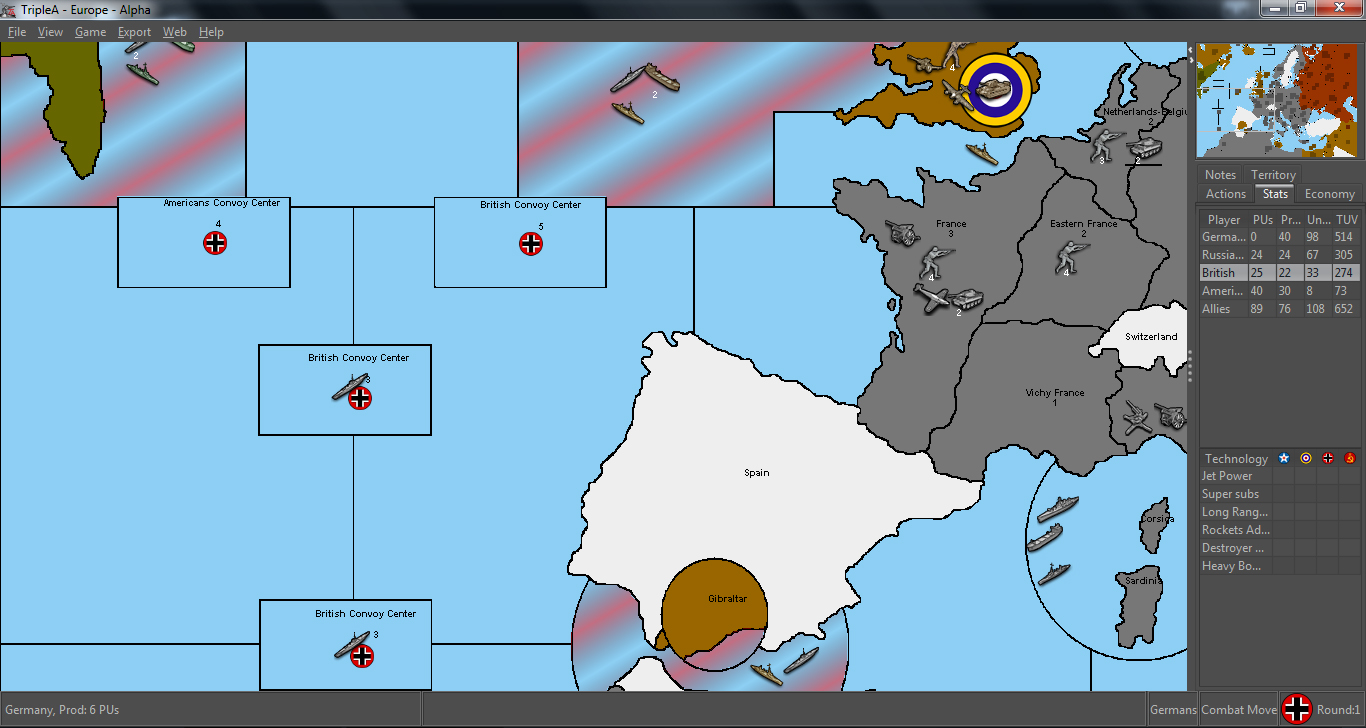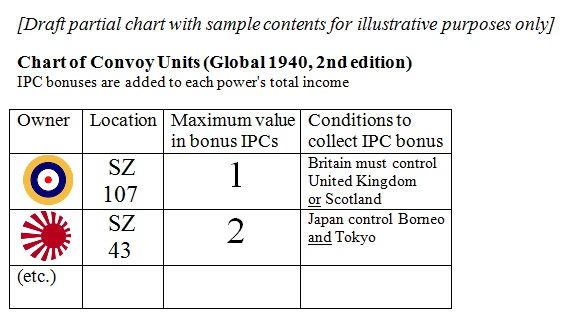Some great feedback and great charts too! I’m stuck at work or I’d write more, but just wanted to chime in real quick like while I’m on my break.
:-D
Taking it back to the Europe 1999 convoy rules, just for reference, its not so much that the convoys there replenished automatically, instead the owner of the convoy (the nation to which it is attached) must control it during their collect income phase. If the enemy takes it you can flip the roundel to indicate that the convoy is currently inactive, and must be recovered by yourself or your team before you get the cash.
Now in Europe 1999, all these convoys are in sea zones that would be otherwise pretty undesirable locations to have your units. They are stuck in the midway points, often between two important sea zones, but not particularly important by themselves, except for the convoy cash. So what generally happens is you’ll see players making a series of “passes” or “sweeps” across the convoy sea zone, first by the enemy to disrupt the convoy cash, then by the original owner/team to try and recover it. Actual combats for control of the convoy in early rounds were rare. Usually the convoy was designed as a way for the Allied economic advantage to become inevitable after the first few rounds.
In other words, the whole unit set up and location of convoys on the map was specifically designed such that Germany could only “disrupt” the convoy cash initially… First by doing these low risk “passes.” And perhaps they can keep this up for a little while. But within a few rounds, the Allies can position units to defend the convoy zones. At this point the German player can no longer disrupt the convoy at no risk just by “sweeping across them”, but instead has to start throwing subs into attacks. Here the control of the convoy is sort of like a bonus on top of destroying the defensive ships (really you just want to take a crack at the ships to whittle away the opponents TUV, but the convoy cash denied to the opponent if you win is there as an extra draw.) In the end though, control of the convoy is usually secured, and it is only at that point when the IPCs are a dependable part of your income.
Its kind of hard to describe without a visual, so here’s a glance at the tripleA map. I’m partial to that map, since I drew the baseline for it in early days hehe…
You can see down below (images attached) that the starting German U-boats were positioned to steal the convoy income away from the Allies, during the first round. In the second round, Allies are usually able to recover a couple of these, whereas most will still be under German control. By the third round the Allies will usually drive the U-Boats back making it harder for Axis to deny the Allies this income, and that’s when the Allied economic advantage will usually start to accelerate and really kick into high gear.
TripleA shows the starting Allied Roundels, being replaced by a German roundel, while the computer tracks the drop in British/American production. But this is a confusing system in a face to face game where the original owner/value of the convoy zone is not drawn directly on the map (as it was in Europe 1999). In a FtF game where that information is not drawn on the map, the best approach would be to use roundels for the original owner/value of the convoy and just flip the roundel (but leave it where it is) if the convoy is “disrupted” ie. taken over by the enemy. That way there is no confusion about which nation collects the income for the zone. Once the roundel is dropped, it stays the where it is, since this indicates “original” ownership.
This was an all or nothing conception of the Convoy Zones, where the British or Americans would lose the whole value of their convoy zone if the Germans disrupted it. It also had them at varying IPC values a 3, a 5, or 6 etc…
If you wanted to replicate that system, but in a game where this information is not already drawn on the physical map (e.g. 1942.2), then the roundel markers would definitely seem to be the easiest method. But I’m getting that the Europe 1999 system would be insufficient to create enough interest for players to go through the trouble of adopting our new HR convoy system. What we really want is a way to improve on Europe 1999 (using it as a model, rather than the Global convoy system) and then add in some elements of excitement, while still keeping things as simple as possible.
So say you wanted to make the values of each convoy zone variable…
and you want this information readable at a glance (without drawing on the map)…
As long each sea zone only contains Convoys from a single Nation (e.g only one type of Nation’s roundel), and as long as all roundels have a universal set value (whatever that is determined to be 1 ipc, 2 ipcs, 3 ipcs?) then you could just place multiple roundels in a zone to indicate the value of the convoy.
Lets explore a base 2 system.
For example
1 roundel = 2 convoys, with 2 gray chips, worth 2 ipcs
2 roundels = 4 convoys, with 4 gray chips, worth 4 ipcs
3 roundels = 6 convoys, with 6 grey chips, worth 6 ipcs
In any given sea zone, all the roundels will belong to the same nation, the original owner, (this is a National Convoy system after all) but by breaking them apart into separate roundels you have an easy way to track the totals at a glance. Again, if you wanted a sea zone worth 6 ipcs, you would place 3 National roundels (each of them representing a convoy worth 2 ipcs = 2 gray chips)
‘Why is this better than using a single roundel with 6 gray chips beneath it for the whole zone?’
Because, in a game where convoys can vary in total value, then as soon as the enemy starts knocking off chips, players might forget what their convoy is worth. They’d have to go back and re-read the set up charts. If you allow for replacement chips, then this confusion might increase during the course of play. Sure players might eventually commit it all to memory, but why force that? This method provides a ready way to know exactly what a given convoy zone is worth (its potential Max value) at any time.
Then you could allow them to be a purchasable unit, and a unit that can be “destroyed” in a way that makes a bit more sense to me. For example… The convoy takes 2 hits, and then the Roundel itself is “exposed”! If the raiding enemy nabs the third hit, the roundel is flipped and the convoy is considered “disrupted”. Now the roundel itself is not worth any IPCs, it is not removed. Here’s the kicker, the Convoy does not automatically repair, instead you can “repair” 2 convoy chips for the cost of 1 ipc! This restores the chips, if the National Roundel is still upright.
If the roundel is flipped, perhaps it costs 3 ipcs, to reactive.
Also, like on Marc’s charts, if one of the conditions is not met for the convoy, like the port of origin or destination territory is captured, then you flip the roundel upside down as well, to indicate that.
I think something like this would be necessary to make a purchase mechanic work, since the whole point of the Convoy unit itself is just as a means for the player to gain more IPCs at collect income.
The convoy chip is just an ipc in waiting. It has no cool combat value, or any other advantages like the other units do, so its kind of a weird thing to pay for, unless as Baron noted, the value for the investment is pretty good. If you have to purchase or spend anything at all in IPCs, to make use of these Convoys, the net benefit in IPCs has to be a lot greater (like twice the value gained), as an incentive to spend that money for convoys rather than on units. Hence the 2 for 1 repair, if the roundel is still upright. You could cap the total number of Convoy roundels that can exist in any one zone. Say at 3 total roundels for your nation.
Then if you like, the player could opt to invest in more Convoys, but only up to that Max value (3 roundels = 6 ipcs, 6 gray chips.)
That’s probably the simplest way I can think of to make a Convoy that is somehow “purchasable,” or which can be diminished by the enemy through some kind of attrition. You could pick any number for the max roundels, 3, or 4, or 6, whatever. The idea is that there is some ceiling or upper limit to the amount a nation can invest in convoys.
Convoys can only exist in the designated “Convoy Zones.” They are represented by the National Roundels, with a consistent value (always worth the same number of IPCs/chips.) If you cap the total number of Convoys per zone, and fix their possible locations, it is conceivable that you could make the Convoy Roundel itself purchasable, so you can add more to a zone over time, but the existing convoys are never totally destroyed, just flipped upside down.
Would something like that make sense?
Then you could try to introduce a combat element into the thing, instead of just a movement phenomenon like the Europe 1999 system. Its still possible to make each convoy worth 3 instead of 2, but then I’m not sure how the purchasing would look, since you can’t really do the "2 for " simple repair thing. Also, if the convoy Roundel is worth 2 chips, you can create a bit more variety in the total ipc values for these zones… At 2 ipcs or 4 ipcs or 6 ipcs for example = slightly worse, slightly better, or twice as good, as the replacement cost of a single infantry unit. 3 ipc convoys couldn’t work here, since each roundel would be worth 2.
If you do the same thing with base 3 ipcs per roundel rather than 2, (like I suggested earlier) you’d have to work with 3, 6, or 9 for the total value of convoys, which might be too much money overall at the high end, given how many zones we want to include?
With a 2 chip per roundel model, maybe you could say that a surface warship only clips one chip at a pass, whereas a sub clips both? Or maybe the sub removes a chip from each roundel it passes, whereas surface warships can only remove chips from a single roundel? Something like that to privilege subs this role?
Also, since the replacement cost can’t be 1 for 1 (the investment would be a wash with no benefit for the investment) would a replacement cost of 2 for 1 be worth it? Using a 2 ipc model, that would mean the convoy owner could repair a loss of 2 chips for the same cost as a loss of only 1 chip. Might that effect the Raiders calculus, as a disincentive to raiding with warships?
I’m waffling when it comes to the set ipc values per roundel. I can see an argument for 2 chips and 3 chips, but it depends on whether you want to give the roundel itself a “hit” and do the whole flipping upside down, restoring to upright for an additional cost idea. I think 2 might be better for a simple “pass/sweep” mechanic, but 3 might be better if you wanted to make a roll for damage mechanic. Not sure though, any thoughts?
All my discussions above assumed 1 gray chip = 1 ipc, though I suppose you could make 1 chip worth 2 ipcs if you wanted. The only thing to keep in mind is how much total income you want to introduce into the game. In my mind it needs to be workable in 1942.2 to have any real shot of adoption, whether in the older world scale games like Classic/Revised/AA50, or the newer 1940 games. If it works and is enjoyable in 1942.2 that would be proof of concept for me. This places some constraints on the total money we can introduce I would think. I would say something like half of the normal starting income, for each nation via convoys, otherwise it could produce out of control spams, and too many total units in an average game.










